Freshwater Snails: A Comprehensive Guide for Your Aquarium in 2024
Freshwater snails are a popular choice for aquarium enthusiasts. These snails are natural algae killers and help keep the water tank clean. However, they can reproduce quickly and take over the tank, which can be troublesome.
To avoid this, it’s essential to carefully research and select snail species before adding them to your fish tank. Regular cleaning and aquarium maintenance are also necessary for a healthy environment.
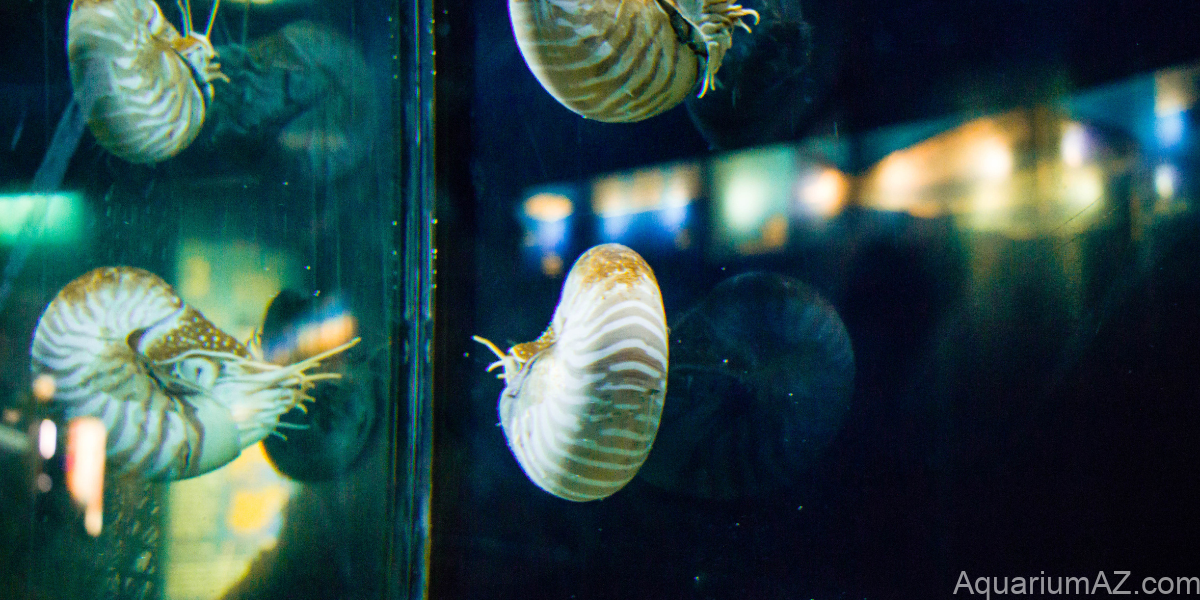
It’s essential to be aware of any changes in water quality and act quickly to correct potential problems. Regular inspection of fish health is also necessary.
Snails in fish tanks can be both helpful and troublesome. As a natural algae killer and uneaten food, they can also eat plants or multiply too quickly.
Understanding water snails, preventing accidental introductions, and doing proper research before buying them can virtually eliminate all problems you encounter.
Snails in fish tanks can be both helpful and troublesome. As a natural algae killer and uneaten food, they can also eat plants or multiply too quickly.
Different types of freshwater snails are valuable additions to aquariums, and they help maintain a clean and balanced aquatic environment in snail tanks. These water snails keep the tank clean and prevent it from becoming anaerobic and compacted.
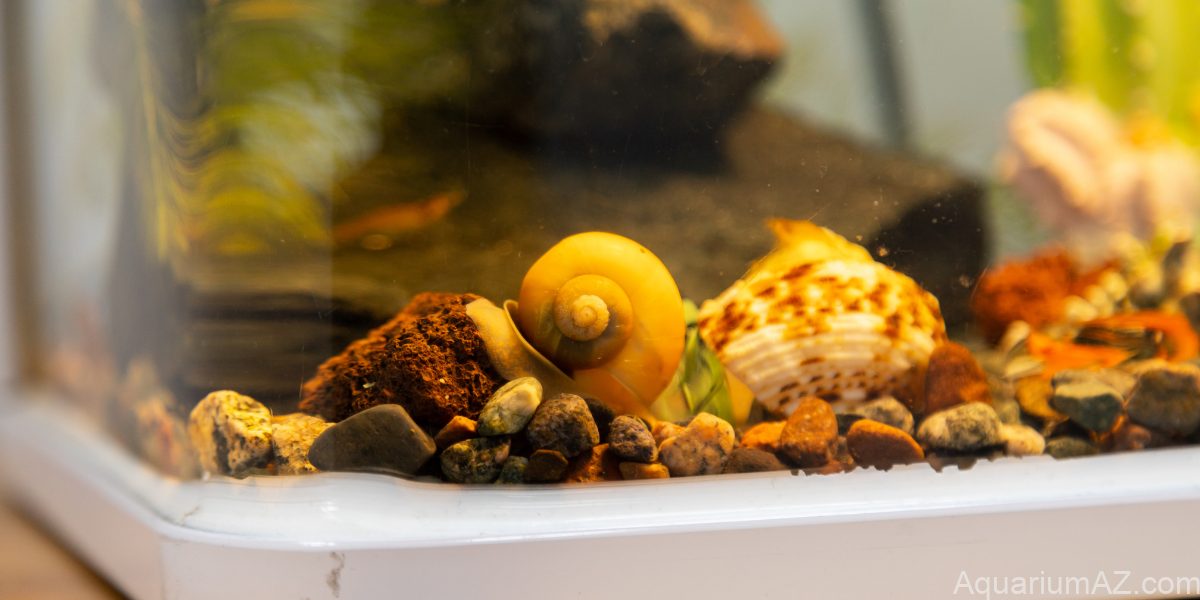
Certain species of freshwater snails are known to excavate into the sand or gravel. However, it’s essential to maintain a balance of water snails in the aquarium to avoid overpopulation.
Snails have become increasingly popular as pets because of their vibrant colours and unique shapes. They are a low-maintenance addition to any aquarium.
However, some species can overrun an aquarium if they multiply unchecked. Malaysian Trumpet Snails and Ramshorn Snails are common examples. Once nuisance snails have invaded your aquarium, getting rid of them is difficult.
Apple snails (Pomacea) can decimate an aquarium quickly with their voracious appetites. In certain parts of the world, they have caused damage to crops after being accidentally released into the wild.
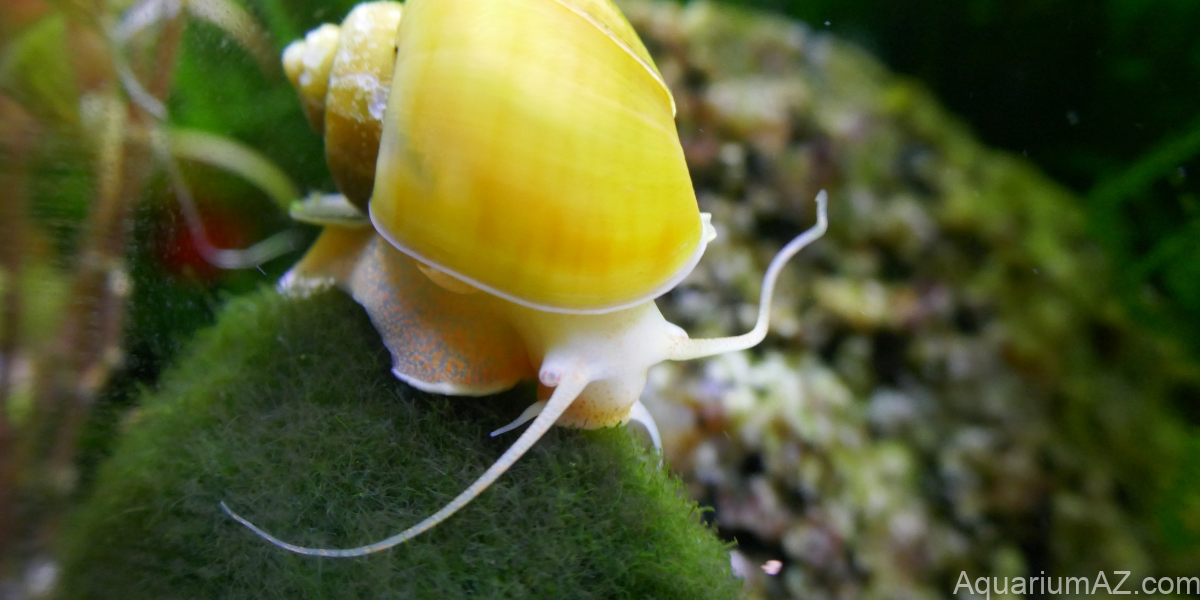
However, most apple snails in aquariums are excellent scavengers and don’t bother plants much.
Usually, snails end up in our aquariums by mistake when they hitch a ride on plants or decorations. We can remove snails and their eggs by using gravel, rocks, plants, driftwood, or decorations.
Malaysian Trumpet snails can survive and reproduce after rinsing the gravel thoroughly.
Let’s Dive into Types of Freshwater Snails
Mystery Snails

Due to their bright colours and algae-eating ability, mystery snails, also called Inca snails, are popular water snails in the aquarium collection.
They have a 3 to 4 years lifespan, grow slightly over 1½ inches in diameter, and come in various colours. Mystery snails have gills and a lung and use a siphon tube to breathe air by coming to the surface.
They require a secure lid to prevent them from climbing out of the tank and breeding through a male and female, with the female able to leave the water to deposit her eggs. Depending on temperature, the eggs hatch in 2 to 3 weeks, and the babies drop into the water.
Rabbit Snails
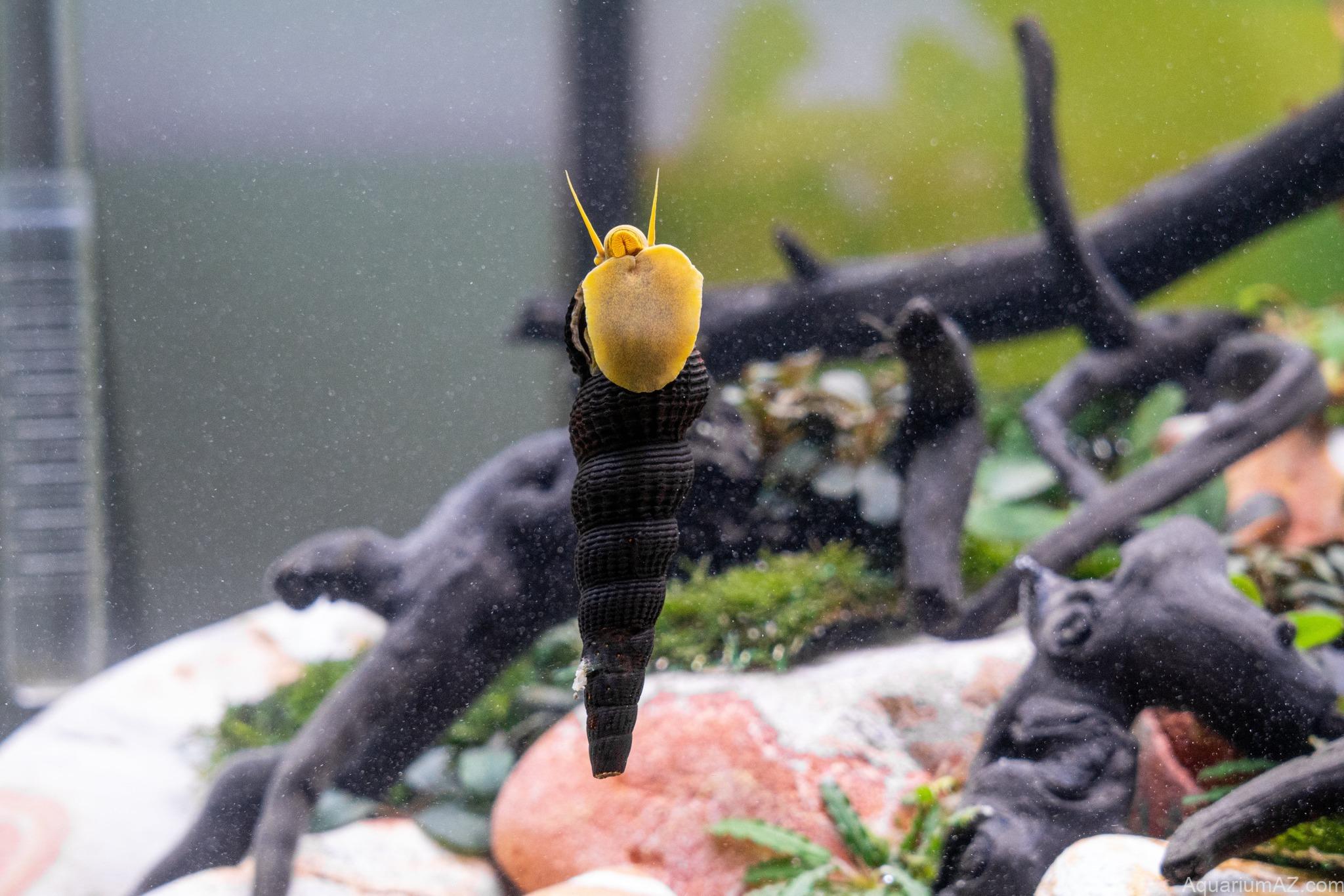
Rabbit snails are a popular choice for aquarium enthusiasts due to their unique appearance, which features a “rabbit-like” face and vibrant colors. These snails are native to Sulawesi, Indonesia and reach a length of 4 inches. They live for about 3 years and thrive in snail tank of 20 gallons or larger.
To keep rabbit snails healthy, it’s important to maintain a warm water temperature of 76°-84°F and keep the pH level slightly alkaline between 7.8-8.4. Some aquarists prefer to add crushed coral to their aquariums to achieve the right water chemistry.
Rabbit snails feed on soft algae, dead plant matter, and other detritus. They also eat sinking pellets, algae wafers, and other fish foods that fall to the bottom, but they do not harm plants. However, there have been reports of nibbling on Java Fern.
These snails reproduce slowly, producing one fully developed young at a time enclosed in a milky white egg pod. They lay eggs every 4-6 weeks. Even if you have multiple snails, their reproductive rate is slow.
Assassin Snails

The assassin snail (Clea helena) is native to southeast Asia and has become a popular choice for aquarium enthusiasts. They are known to eat other snails, making them a natural solution for reducing nuisance snail populations.
They have yellow and brown stripes on their bodies that make them resemble bumblebees, and they grow to about an inch in length. They like to burrow in the substrate but come out quickly to eat.
Assassin snails are carnivores and mainly feed on other snails or carrion. However, they don’t eat their own kind even when other food is scarce.
Some shrimp breeders have reported that Assassin snails eat their valuable shrimp, but experts believe this happens rarely, and the victims are usually weak or sickly.
Assassin snails breed in captivity, and to breed them, you need at least five or six to make sure you have males and females. They are gonochoristic, and females lay only one to four eggs at a time.
The eggs are transparent and hard to see, and they hatch in 8 to 9 weeks, depending on the temperature.
Ramshorn Snails
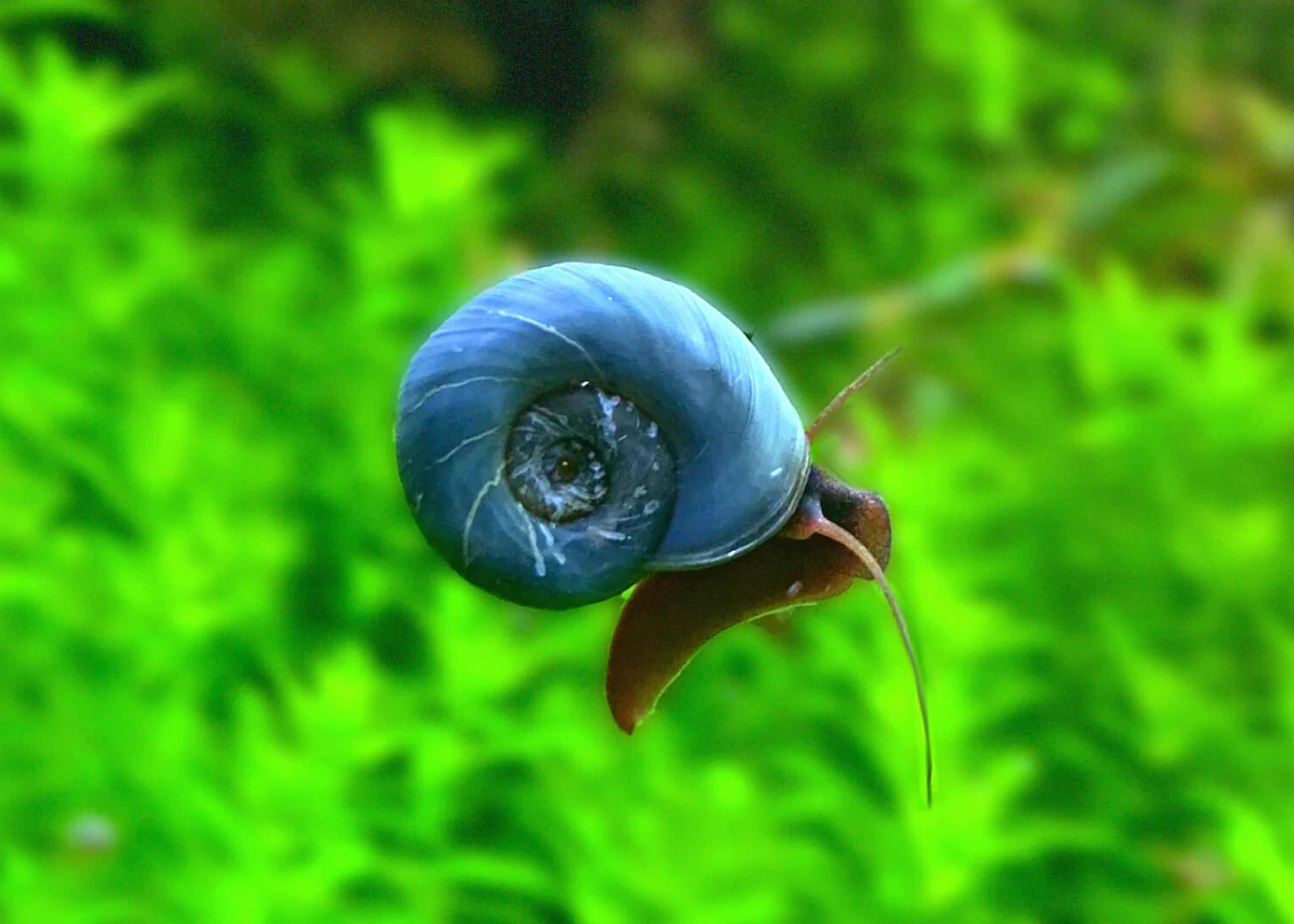
Ramshorn snails are common in the aquarium hobby and can help keep tanks clean. However, some people see them as pests that need to be eliminated.
They eat leftover food, dead plant matter, and soft algae. But, in tanks with lots of organic debris, their population can quickly grow in numbers. When food is scarce, they also eat soft-leafed plants.
Two types of Ramshorn snails exist: Red Ramshorns and Great Ramshorns. Red Ramshorns are red, while Great Ramshorns are usually olive-yellow to brown with stripes on their shell.
Other colours like pink, yellow, or blue are also available. Ramshorns are air-breathers and need to come to the surface to breathe.
Great Ramshorn water snails are commonly introduced intentionally into tanks to control algae and keep them clean. However, Red Ramshorns often appear spontaneously.
They can sneak in on live plants, rocks, driftwood, ornaments, and even gravel transferred from another tank. Their population can quickly grow if detritus and organic waste build up in the tank.
It’s important to monitor the population of Ramshorn snails in your tank. If their numbers suddenly increase, it could result from detritus and organic waste building up in the tank. To control their population, remove excess food and debris from the tank or introduce natural predators.
The Malaysian Trumpet Snail
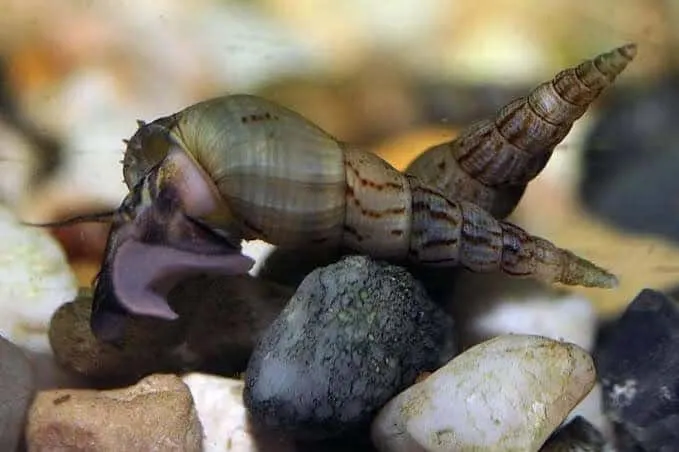
The Malaysian Trumpet Snail (MTS) is a small algae-eating snail, cone-shaped water snail that is parthenogenetic, meaning females are capable of giving birth to more females without requiring contact with a male.
This makes them highly prolific and virtually impossible to eliminate once they enter the snail tank. They can multiply rapidly, with a single hitch-hiking female being enough to get the population going.
MTS forage in the substrate by day, keeping it aerated and breaking down any organic debris and waste that accumulates there, preventing anaerobic conditions which can release deadly hydrogen sulfide gas from developing.
They make excellent scavengers for planted aquariums, shrimp tanks, and aquariums that are heavily stocked or fed generously. They are particularly useful for aquarists who prefer natural methods of cleaning their aquariums rather than chemical cleaners.
However, some aquarists can regarded MTS as pests. Seeing that many snails in a tank or watching the gravel “move” can be a little creepy.
Moreover, it is pretty much impossible to eradicate MTS entirely once they are in your snail’s water tank. Nevertheless, cutting back on feeding and vacuuming the substrate regularly will deprive these snails of their food source, and thus, keep their numbers down.
In summary, while MTS can be a blessing or a curse depending on your perspective, they are undoubtedly interesting and useful snails in fish tanks.
Pond Snails

Pond snails are a diverse group of freshwater snails commonly found in many aquatic environments, including ponds, lakes, and aquariums. They come in many different species, varying in size, shape, and colouration.
Some hobbyists keep them as valued scavengers, while others consider them pests due to their rapid reproduction rates.
Most pond snails grow to be an inch or less long and have an olive-green to speckled brown colouration. They are omnivores and feed on various food sources, including algae, dead plant material, detritus, and uneaten fish food.
They don’t typically harm live plants, but they can reproduce rapidly with ample food.
If you want to keep pond snails in your aquarium or shrimp tank, they can make great scavengers and are generally peaceful with other community fish.
However, to prevent their populations from getting out of control, it’s important to keep organic debris to a minimum by doing regular water changes, vacuuming debris, and feeding sparingly.
If you maintain their population correctly, you can benefit from pond snails as a natural algae killer.
Nerits Snail
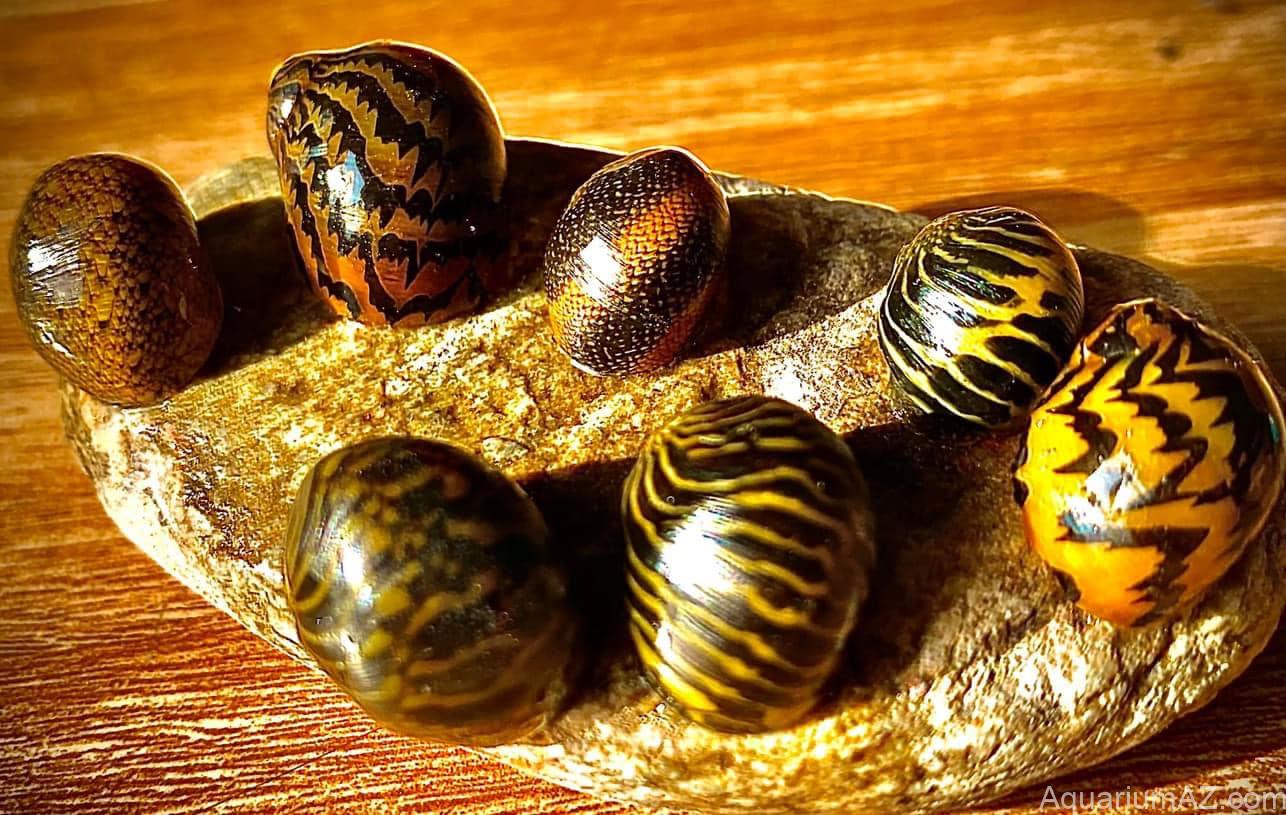
Nereites (Neritina spp.) are fantastic algae-eating snails that also eat leftover fish food, dead plants, and other discarded matter. Among them are some with horns available in different colours and patterns.
They are among the most beautiful water snails for snail tanks. They are relatively small, they don’t eat plants and their waste contains bacteria that are beneficial to the digestive tracts of shrimp, making them perfect for planted aquariums and shrimp tanks.
Nerite snails are not difficult to breed, but the larvae require brackish or saltwater to develop, so there is little risk of them overrunning an aquarium. They are thought to live at least 3 years, but there are reports of 5 years from hobbyists. They love to crawl out of the water, so ensure you have a secure lid on your tank!
What are Water Requirements?
When it comes to keeping snails in an aquarium, it is crucial to maintain good water quality. While snails are not particularly demanding regarding water parameters, ensuring their environment is healthy and conducive to their well-being is important.
To achieve this, it is recommended to feed snails in moderation, perform regular water changes, and maintain efficient filtration. Regularly testing the water chemistry is also essential to ensure optimal water conditions for all your aquatic pets.
This will help you identify any potential water quality issues and take corrective action promptly to prevent any health problems or stress to your snails.
How to Feed Snails?
Feeding snails can be easy. They usually eat algae, dead plants, and bits of fish food. If you want to give them more, Aqueon Algae Rounds and Bottom Feeder Tablets work well. Snails need calcium for healthy shells, so make sure they get enough. If you use reverse osmosis or deionised water, add Aqueon Water Renewal to return the minerals and trace elements. You can put crushed coral in the filter, add liquid calcium to the tank, or even try Zilla Aquatic Turtle Food to add more calcium.
If you prefer more natural methods, try feeding your snails blanched kale, spinach, Chinese cabbage, green beans, or broccoli. These vegetables are rich in calcium. Be careful not to give too much food and remove any uneaten food to avoid water quality issues.
Keep your aquarium free of nuisance snails
Aquarium enthusiasts often face the problem of nuisance snails. These pests can be quite challenging to eliminate once they enter the aquarium. To prevent this from happening, it is important to take some precautions. Here are a few things you can do:
- Using bleach water or scrubbing it thoroughly is the best way to prepare your aquarium decor.
- Inspect the gravel used carefully before adding it to your aquarium. Don’t add snails from unknown or unwanted sources.
- To display live plants, you can soak them in a mixture of 2 to 3 tablespoons of Alum powder per gallon of water or keep them isolated for at least 15 days before being displayed.
Getting Rid Of Nuisance Snails
Reduce snail numbers by taking steps to control them. It’s impossible to eliminate them entirely, but these measures can help.
- Vacuum gravel regularly and siphon out dead plant material and detritus to eliminate their food supply.
- To control the amount of food and waste available to snails, it’s recommended that you feed your fish less. This can help manage the snail population in your aquarium.
- Aquarium snails can be a nuisance, but you can remove them by hand, trap or bait. Try Aqueon Algae Rounds, Bottom Feeder Tablets or lettuce leaves overnight to catch them. You can also easily net Red Ramshorn snails when they come up to breathe. Keep your aquarium healthy!
- Let your fish eat snails by crushing a few at a time!
- Get rid of nuisance snails by introducing Assassin snails.
- The text suggests that certain species of fish like loaches, catfish, cichlids, and puffers eat snails, and can help reduce the number of snails in your tank. However, one should research the fish before purchasing to ensure that they are suitable for the tank size and compatible with its residents
- Snail-killing products should be used as a last resort and with caution.
- Chemical treatments can harm plants, shrimp, invertebrates, and some fish.
- If you choose to use chemical treatments, the snails must be removed.
- A mass die-off of snails can over-burden your filter and cause ammonia and nitrite levels to rise.
What is the problem with using medications and other additives with snails?
Some medications and chemicals can harm snails and other invertebrates in your aquarium. However, most other water treatments are safe to use in their presence. You must read the instructions and ingredient lists for any treatment you plan to use in your aquarium. This is to ensure the safety of your aquatic pets.
Adding snails to an aquarium can add value and interest since they are a part of nature.
